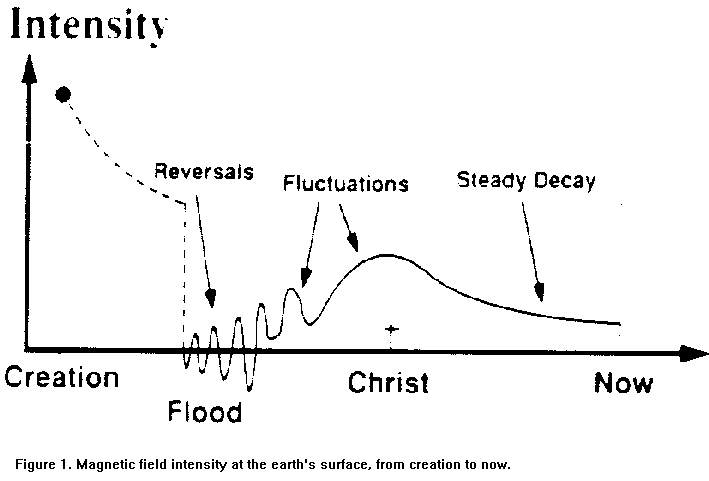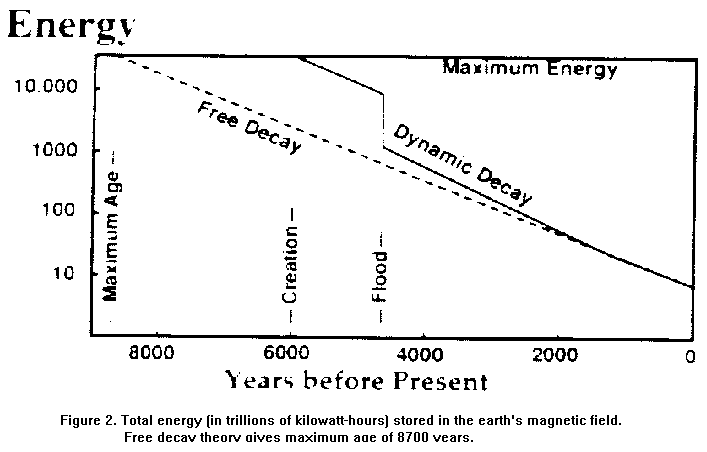The earth's magnetic field is a powerful witness for a world much younger than the billions of years required by evolutionary theories. Let's start the story with the most prominent feature of the field today--its very rapid decay.
The Field Is Decaying Rapidly
The average "intensity" of the earth's magnetic field has decreased exponentially by about 7% since its first careful measurement in 1829.[1] The field's intensity includes components of strength and direction and tells us the amount of force turning a compass needle northward. By estimating the field intensity everywhere (in, on, and above the earth), we can calculate the total electrical "energy" stored in the field. Such calculations show that the total energy in the field has decreased by about 14% since 1829.
This rapid decay of both energy and intensity was not widely known, even among scientists, until Dr. Thomas Barnes, a creationist physicist, began publicizing it in 1971.[2] He pointed out that such a decay would occur very naturally if the electrical current producing the field were slowly losing energy because of the electrical resistance of the core.[3] This theory is called "free decay." The observed decay rate is exactly what one would expect from the electrical properties of the materials most likely to be in the core.[4]
The free-decay theory contradicts the evolutionary "dynamo" theories, which claim that complex processes in the earth's core have converted heat energy into electrical energy, much like an electric generator, maintaining the field for billions of years.[5] Many intelligent scientists have been working on dynamo theories for over four decades without great success. Furthermore, recent measurements of electric currents in the sea floor weigh heavily against the most popular class of dynamo theories.[6]
Thus evolutionary dynamo theories do not have a good explanation for the rapid decay of the field, whereas the free-decay theory does. However, our historical data on the intensity of the field only goes back to 1829. Was the field decaying before that? Fortunately, there is a scientific way to answer that question.
"Archaeomagnetism" is the study of the magnetization of bricks, pottery, campfire stones, and other man-related objects studied by archaeologists. Iron oxides in those objects retain a record of the strength and direction of the earth's magnetic field at the time they last cooled to normal temperatures. Archaeomagnetic data taken worldwide show that the intensity of the earth's magnetic field was about 40% greater in 1000 A.D. than it is today, and that it has declined steadily since then.[7]
Such a rapid decay could not have been going on continuously for millions of years, because the field would have to have been impossibly strong in the past in order for it to still exist today. Creationists of the 1970s extrapolated today's decay back into the past, showing that the field could not be more than about 10,000 years old, assuming a constant decay of intensity.
Unfortunately, the archaeomagnetic data do not support that assumption.[7] Instead, the data show that the field intensity at the earth's surface fluctuated wildly up and down during the third millennium before Christ (see figure 1). A final fluctuation slowly increased the intensity until it reached a peak (50% higher than today) at about the time of Christ. Then it began a slowly accelerating decrease. By about 1000 A.D., the decrease was nearly as fast as it is today.

The Field Has Reversed Direction Many Times
"Paleomagnetism" is the study of magnetization locked into rocks at the time of their formation. Paleomagnetic data show that while the geologic strata were being laid down, the earth's magnetic field reversed its direction hundreds of times. Reversals are a very severe departure from steady decay of intensity.
Both archaeomagnetic and paleomagnetic data contradict the early creationist assumption of constant decay of intensity. In 1988 I published a review paper documenting the great diversity and reliability of the data.[8]
A Creationist Theory for Reversals and Fluctuations
The validity of the data required a new theory to explain them. In 1986 I suggested that strong flows of the fluid in the earth's core could produce rapid reversals of the field during and after the Genesis flood.[9] The resulting disturbances in the core would cause the field intensity at the earth's surface to fluctuate up and down for thousands of years afterwards.
This "dynamic-decay" theory is a more general version of the free-decay theory, since it takes account of motions in the core fluid. Dynamic decay explains the main features of the data, especially several features evolutionists find puzzling. In 1988, startling new evidence was found for the most essential prediction of my theory--very rapid reversals;[10] and in 1990, I showed a specific physical mechanism for such reversals.[11]
The Field's "Energy" Has Always Decreased
According to the dynamic-decay theory, the "energy" in the field has always decreased rapidly. In fact, the energy loss during reversals and fluctuations would have been even faster than today's rate. This information allows us to estimate the age of the field.
The data and the dynamic-decay theory imply that, ever since creation, the field has always lost at least half its energy every 700 years. Figure 2 illustrates the factors involved. The maximum energy in the figure comes from another theory I proposed about the nature of the field when God created the earth, a theory which successfully predicted space probe measurements of planetary magnetic fields.[12] Extrapolating today's energy decay rate back (along the dotted straight line labeled "free decay") to that limit yields a maximum age of 8700 years. According to the dynamic-decay theory, the true age would be less than that because of extra losses during the reversals and fluctuations. The solid line (labeled "dynamic decay") shows that with a significant loss of energy during the Genesis flood, the age of the field would be about 6000 years.

Are There Any Loopholes in the Logic?
The precise age limits above depend not only on the dynamic decay theory, but also on the theory of planetary magnetic-field origins. However, we can still set a rough maximum to the initial energy from basic physical considerations, as Dr. Barnes has done.[2] Such a maximum would limit the age to roughly 10,000 years.
It is also possible that a small percentage of today's energy decay is not free decay, due to the core's electrical resistance; but rather is dynamic decay, due to residual motions in the core fluid. In that case, the resistance of the core would be less, and the maximum age of the field would be greater. But even in this extreme case, the maximum age would still be only about 100,000 years, far short of the billions of years evolution needs.
Conclusion
At present, the only working theory for the origin, fluctuations, rapid reversals, and decay of the field is a creationist theory--a theory that fits all the data. Thus, according to the best theory and data we have, the earth's magnetic field certainly is less than 100,000 years old; very likely less than 10,000 years old, and fits in well with the face-value Biblical age of 6,000 years.
References
- McDonald, K. L. and R. H. Gunst. "An analysis of the earth's magnetic field from 1835 to 1965," ESSA Technical Report IER 46-IES 1 (July 1967) U.S. Government Printing Office, Washington, D.C., Table 3, p. 14.
- Barnes, T. G. "Decay of the earth's magnetic moment and the geochronological implications," Creation Research Society Quarterly 8 (June 1971) 24-29.
- Barnes, T. G. "Electromagnetics of the earth's field and evaluation of electric conductivity, current, and Joule heating of the earth's core," Creation Research Society Quarterly 9 (March 1973) 222-230. Decay rate implies conductivity of 40,000 mho/m.
- Stacey, F. D. "Electrical resistivity of the earth's core," Earth and Planetary Science Letters 3 (1967) 204-206. Likely core materials imply conductivity of roughly 33,000 mho/m, agreeing with Ref. 3.
- Inglis, D. R. "Dynamo theory of the earth's varying magnetic field," Reviews of Modern Physics 53 (July 1981) 481-496.
- Lanzerotti, L. J., et al. "Measurements of the large-scale direct-current earth potential and possible implications for the geomagnetic dynamo," Science 229 (5 July 1986) 47-49.
- Merrill, R. T. and M. W. McElhinney. The Earth's Magnetic Field (London: Academic Press, 1983) 101-106.
- Humphreys, D. R. "Has the earth's magnetic field ever flipped?" Creation Research Society Quarterly 25 (December 1988) 89-94.
- Humphreys, D. R. "Reversals of the earth's magnetic field during the Genesis flood," Proceedings of the First International Conference on Creationism, Vol. II (Pittsburgh: Creation Science Fellowship, 362 Ashland Avenue, 1986) 113-126.
- Coe, R. S. and M. Prevot. "Evidence suggesting extremely rapid field variation during a geomagnetic reversal," Earth and Planetary Science Letters 93 (April 1989) 292-298.
- Humphreys, D. R. "Physical mechanism for reversals of the earth's magnetic field during the flood," Proceedings of the Second International Conference on Creationism, Vol. II (Pittsburgh: Creation Science Fellowship, 362 Ashland Avenue, 1990) 129-142.
- Humphreys, D. R. "The creation of planetary magnetic fields," Creation Research Society Quarterly 21 (December 1984) 140-149, records the predictions. Humphreys, D.R. "Good news from Neptune: The Voyager II magnetic measurements," Creation Research Society Quarterly 27 (June 1990) 15-17, reports the confirmation of the predictions. See also Humphreys, D. R. "Beyond Neptune: Voyager II supports creation," ICR Impact No. 203 (May 1990).
* At time of publication, Dr. Humphreys was an ICR Adjunct Professor of Physics and a physicist at Sandia National Laboratories, Albuquergue, New Mexico. The Laboratories have not supported this work.
Cite this article: Humphreys, D. R. 1993. The Earth’s Magnetic Field Is Young. Acts & Facts. 22 (8).



